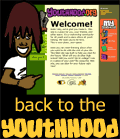
|
||
Research-Based DesignYouthhood is based upon research on healthy adolescent development, educational standards, and IDEA transition guidelines. The site carefully and intentionally seeks to meet the psycho-social and educational-emotional needs of all youth. The following describes the philosophies and research studies upon which the Youthhood site is built. Youth DevelopmentYouth development is a process which prepares young people to meet the challenges of adolescence and adulthood through a coordinated, progressive series of activities and experiences which help them to become socially, morally, emotionally, physically, and cognitively competent (National Youth Development Center, n.d.). Positive youth development addresses the broader developmental needs of youth, in contrast to deficit-based models which focus solely on youth problems. Youth development as an asset-building approach (Benson, 1995):
Raising TeensA synthesis of research from the Harvard School of Public Health (Simpson, 2001) found ten tasks of adolescent development common to all youth. Youth must:
From these ten tasks, five ways in which adults can support these adolescent developmental needs are suggested. These include:
The Youthhood curriculum seeks to support youth in their developmental tasks and to engage adults as allies in this work. Youthhood promotes the concept of youth working hand-in-hand with adult mentors as they explore content, try activities, and pursue personal goals through use of the Life Map. The role of adults working with youth is to provide guidance, insight, support, and advocacy so that youth can make a successful transition from high school to postsecondary training, employment, and adult life. ReferencesBenson, P.L. (1995). Uniting communities for youth: Mobilizing all sectors to create a positive future. Minneapolis, MN: Search Institute. National Youth Development Center. (n.d.). What is youth development? Retrieved March 2, 2005 from http://www.nydic.org/nydic/programming/whatis/index.htm Simpson, A.R. (2001). Raising teens: A synthesis of research and a foundation for action. Boston: MA: Harvard School of Public Health, Center for Health Communication. Retrieved March 2, 2005 from http://www.hsph.harvard.edu/chc/parenting/raising.html |
||
What Can I Do Here? | Help FAQs | Curriculum Guide
Privacy | Disclaimer | About | Contact Us | Homepage
 |
 |
 |
©2006 Regents of the University of
Minnesota.
This page was updated December 5, 2018
The University of Minnesota is an equal opportunity educator and employer. Online Privacy











